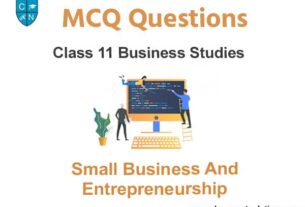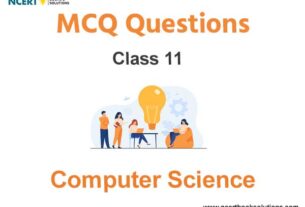Please refer to MCQ Questions The p Block Elements for Chapter 2 Class 11 Chemistry given below. All MCQ questions are provided with answers. These MCQ Questions for Class 11 Chemistry are designed based on the chapters given in your CBSE NCERT Textbook for Class 11 Chemistry. These MCQ Questions are expected to come in your class 11 Board exams.
MCQ Questions The p Block Elements with Answers
Question. The stability of +1 oxidation state among Al, Ga, In and Tl increases in the sequence
(a) Al < Ga < In < Tl
(b) Tl < In < Ga < Al
(c) In < Tl < Ga < Al
(d) Ga < In < Al < Tl
Answer
A
Question. Aluminium(III) chloride forms a dimer because aluminium
(a) belongs to 3rd group
(b) can have higher coordination number
(c) cannot form a trimer
(d) has high ionization energy.
Answer
B
Question. Which one of the following elements is unable to form MF6 3– ion?
(a) Ga
(b) Al
(c) B
(d) In
Answer
C
Question. The correct order of atomic radii in group 13 elements is
(a) B < Al < In < Ga < Tl
(b) B < Al < Ga < In < Tl
(c) B < Ga < Al < Tl < In
(d) B < Ga < Al < In < Tl
Answer
D
Question. AlF3 is soluble in HF only in presence of KF. It is due to the formation of
(a) K3[AlF3H3]
(b) K3[AlF6]
(c) AlH3
(d) K[AlF3H]
Answer
B
Question. The tendency of BF3, BCl3 and BBr3 to behave as Lewis acid decreases in the sequence
(a) BCl3 > BF3 > BBr3
(b) BBr3 > BCl3 > BF3
(c) BBr3 > BF3 > BCl3
(d) BF3 > BCl3 > BBr3
Answer
B
Question. Which of the following structure is similar to graphite?
(a) B4C
(b) B2H6
(c) BN
(d) B
Answer
C
Question. The type of hybridisation of boron in diborane is
(a) sp3-hybridisation
(b) sp2-hybridisation
(c) sp–hybridisation
(d) sp3d2-hybridisation.
Answer
A
Question. Which of the following statements about H3BO3 is not correct?
(a) It has a layer structure in which planar BO3 units are joined by hydrogen bonds.
(b) It does not act as proton donor but acts as a Lewis acid by accepting hydroxyl ion.
(c) It is a strong tribasic acid.
(d) It is prepared by acidifying an aqueous solution of borax.
Answer
C
Question. Which of the following is incorrect statement ?
(a) SnF4 is ionic in nature.
(b) PbF4 is covalent in nature.
(c) SiCl4 is easily hydrolysed.
(d) GeX4 (X = F, Cl, Br, I) is more stable than GeX2.
Answer
B
Question. Which of the following species is not stable?
(a) [SiCl6]2–
(b) [SiF6]2–
(c) [GeCl6]2–
(d) [Sn(OH)6]2–
Answer
A
Question. Boron compounds behave as Lewis acids, because of their
(a) ionisation property
(b) electron deficient nature
(c) acidic nature
(d) covalent nature.
Answer
B
Question. Boric acid is an acid because its molecule
(a) contains replaceable H+ ion
(b) gives up a proton
(c) accepts OH– from water releasing proton
(d) combines with proton from water, molecule.
Answer
C
Question. It is because of inability of ns2 electrons of the valence shell to participate in bonding that
(a) Sn2+ is oxidising while Pb4+ is reducing
(b) Sn2+ and Pb2+ are both oxidising and reducing
(c) Sn4+ is reducing while Pb4+ is oxidising
(d) Sn2+ is reducing while Pb4+ is oxidising.
Answer
D
Question. Which of the following oxidation states are the most characteristic for lead and tin respectively?
(a) +2, +4
(b) +4, +4
(c) +2, +2
(d) +4, +2
Answer
A
Question. Carbon and silicon belong to (IV) group. The maximum coordination number of carbon in commonly occurring compounds is 4, whereas that of silicon is 6. This is due to
(a) availability of low lying d-orbitals in silicon
(b) large size of silicon
(c) more electropositive nature of silicon
(d) both (b) and (c).
Answer
A
Question. In graphite, electrons are
(a) localised on each C-atom
(b) localised on every third C-atom
(c) spread out between the structure
(d) present in antibonding orbital.
Answer
C
Question. Identify the correct statements from the following :
(A) CO2(g) is used as refrigerant for ice-cream and frozen food.
(B) The structure of C60 contains twelve six carbon rings and twenty five carbon rings.
(C) ZSM-5, a type of zeolite, is used to convert alcohols into gasoline.
(D) CO is colourless and odourless gas.
(a) (A), (B) and (C) only
(b) (A) and (C) only
(c) (B) and (C) only
(d) (C) and (D) only
Answer
D
Question. Which of the following does not show electrical conduction?
(a) Diamond
(b) Graphite
(c) Potassium
(d) Sodium
Answer
A
Question. Which of the following types of forces bind together the carbon atoms in diamond?
(a) Ionic
(b) Covalent
(c) Dipolar
(d) van der Waals
Answer
B
Question. Which of the following is an insulator?
(a) Graphite
(b) Aluminium
(c) Diamond
(d) Silicon
Answer
C
Question. Percentage of lead in lead pencil is
(a) 80
(b) 20
(c) zero
(d) 70
Answer
C
Question. Which statement is wrong?
(a) Beryl is an example of cyclic silicate.
(b) Mg2SiO4 is orthosilicate.
(c) Basic structural unit in silicates is the SiO4 tetrahedron.
(d) Feldspars are not aluminosilicates.
Answer
D
Question. Which of the following anions is present in the chain structure of silicates?
(a) (Si2O52–)n
(b) (SiO32–)n
(c) SiO4 4–
(d) Si2O7 6–
Answer
B
Question. Which one of the following statements about the zeolite is false?
(a) They are used as cation exchangers.
(b) They have open structure which enables themto take up small molecules.
(c) Zeolites are aluminosilicates having three dimensional network.
(d) Some of the SiO44– units are replaced by AlO45– and AlO6 9– ions in zeolites.
Answer
D
Question. Which of these is not a monomer for a high molecular mass silicone polymer?
(a) Me3SiCl
(b) PhSiCl3
(c) MeSiCl3
(d) Me2SiCl2
Answer
A
Question. Name the two types of the structure of silicate in which one oxygen atom of [SiO4]4– is shared?
(a) Linear chain silicate
(b) Sheet silicate
(c) Pyrosilicate
(d) Three dimensional
Answer
C
Question. The straight chain polymer is formed by
(a) hydrolysis of CH3SiCl3 followed by condensation polymerisation
(b) hydrolysis of (CH3)4Si by addition polymerisation
(c) hydrolysis of (CH3)2SiCl2 followed by condensation polymerisation
(d) hydrolysis of (CH3)3SiCl followed by condensation polymerisation.
Answer
C
Question. The basic structural unit of silicates is
(a) SiO32–
(b) SiO4 2–
(c) SiO–
(d) SiO4 4–
Answer
D
Question. The substance used as a smoke screen in warfare is
(a) SiCl4
(b) PH3
(c) PCl5
(d) acetylene
Answer
A
Question. Which of the following compounds is used in cosmetic surgery?
(a) Silica
(b) Silicates
(c) Silicones
(d) Zeolites
Answer
C
Question. The non-metal oxides are ____x____ whereas metal oxides are ___y ____ in nature.
(a) x = acidic or neutral, y = basic
(b) x = acidic, y = neutral
(c) x = basic, y = acidic
(d) x = neutral, y = basic
Answer
A
Question. The relationship between first, second and third ionisation enthalpies of each group-13 element is
(a) ΔiH1 > ΔiH2 > ΔiH3
(b) ΔiH1 < ΔiH2 < ΔiH3
(c) ΔiH1 = ΔiH2 > ΔiH3
(d) ΔiH3 > ΔiH1 > ΔiH2
Answer
B
Question. Which of the following properties of aluminium makes it useful for food packaging ?
(a) Good electrical conductivity
(b) Good thermal conductivity
(c) Low density
(d) Non toxicity
Answer
C
Question. Which of the following is/are true regarding gallium?
(i) It has unusually low melting point (303 K).
(ii) It exist in liquid state during summer.
(iii) It has a high boiling point (2676 K).
The correct option is
(a) (i) and (ii)
(b) (i) and (iii)
(c) (i), (ii) and (iii)
(d) (ii) and (iii)
Answer
C
Question. Which of the following is most abundant in the earth crust ?
(a) Boron
(b) Aluminium
(c) Gallium
(d) Thallium
Answer
B
Question. Ionisation enthalpy (ΔiH1kJ mol–1) for the elements of Group 13 follows the order.
(a) B > Al > Ga > In > Tl
(b) B < Al < Ga < In < Tl
(c) B < Al > Ga < In > Tl
(d) B > Al < Ga > In < Tl
Answer
D
Question. Which of the following does not form M3+ ion?
(a) Boron
(b) Aluminium
(c) Indium
(d) Gallium
Answer
A
Question. The group 13 element that is liquid during summer and used for measuring high temperature is
(a) Boron
(b) Aluminium
(c) Gallium
(d) Indium
Answer
C
Question. Thallium shows different oxidation states because
(a) it is transition element
(b) of inert pair effect
(c) of its amphoteric character
(d) of its higher reactivity
Answer
B
Question. The element which shows least metallic character is
(a) Indium
(b) Boron
(c) Aluminium
(d) Gallium
Answer
B
Question. Which one of the following has the lowest m.p.?
(a) B
(b) Al
(c) Ga
(d) Tl
Answer
C
Question. The exhibition of highest co-ordination number depends on the availability of vacant orbitals in the central atom. Which of the following elements is not likely to act as central atom n 3 MF63− ?
(a) B
(b) Al
(c) Ga
(d) In
Answer
A
Question. The strongest Lewis acid is
(a) BF3
(b) BCl3
(c) BBr3
(d) BI3
Answer
D
Question. AlCl3 on hydrolysis gives
(a) Al2O3. H2O
(b) Al(OH)3
(c) Al2O3
(d) AlCl3.6H2O
Answer
B
Question. Which metal is protected by a layer of its own oxide?
(a) Al
(b) Ag
(c) Au
(d) Fe
Answer
A
Question. Aluminium vessels should not be washed with materials containing washing soda because
(a) washing soda is expensive
(b) washing soda is easily decomposed
(c) washing soda reacts with aluminium to form soluble aluminate
(d) washing soda reacts with aluminium to form insoluble aluminium oxide
Answer
C
Question. Which out of the following compounds does not exist?
(a) BF3
(b) TlCl3
(c) TlCl5
(d) Both (b) and (c)
Answer
C
Question. Aluminium chloride is a/an
(a) Bronsted – Lowery acid
(b) Arhenius acid
(c) Lewis acid
(d) Lewis base
Answer
C
Question. Boron forms covalent compound due to
(a) higher ionization energy
(b) lower ionization energy
(c) small size
(d) Both (a) and (c)
Answer
D

We hope you liked the above MCQ Questions The p Block Elements with Answers. Please let us know if you have any questions


